| The following is a copy of a letter sent to the Arizona Attorney General February 26, 2001 by Pinal Citizens for Sustainable Communities. |
February 26, 2001
Dear Ms. Napolitano;
The purpose of this letter is twofold:
We believe the report was falsified so as to make it appear as though it could not be confirmed that contaminants from the Page-Trowbridge landfill leaked to groundwater We believe that the willful falsification of the report to ADEQ constitutes an illegal attempt to mislead ADEQ and the public regarding the impact of the Page-Trowbridge radioactive/toxic waste landfill on the water supply. Our interest in this matter stems from the fact that residents of several local communities rely on the groundwater that lies beneath the Page-Trowbridge landfill as their sole source of water. Because the public health is at stake, we consider any impropriety in reporting the impact of the Page-Trowbridge landfill on our water supply to be an extremely serious offense, and look to your office to investigate this matter vigorously. The attachment elaborates the details of this matter and presents evidence supporting our allegations. Please direct all correspondence in this matter to the undersigned. Sincerely,
Attachment |
CC:
|
|
Introduction The facts show that the University of Arizona (UA) and/or Turner Laboratories Inc. (Turner Labs) concealed the results of a test performed on samples taken April 26, 2000 at the Page-Trowrbridge radioactive/toxic waste landfill. The test results were concealed by willfully omitting them from a report on the status of groundwater at the Page- Trowrbridge landfill submitted to the Arizona Department of Environmental Quality (ADEQ) dated June 14, 2000. The reason the test results were concealed was to make it appear as though the detection of contaminants in the April 26 samples was the result of an unexplained event and did not confirm that contaminants from the Page-Trowrbridge landfill had leaked to groundwater. According to the UA, the presence of a contaminant is confirmed only if two independent tests conducted on samples obtained during the same sampling event both detect the contaminant. By falsely claiming contaminants were detected in only one test done on the April 26 samples, the UA fabricated a need to re-sample and re-test groundwater from beneath the Page-Trowbridge landfill so as to confirm the finding of contaminants via tests on these subsequent samples. Based on the fabricated need for another set of samples, UA personnel claim to have made an unscheduled trip to the Page-Trowbridge landfill on May 17, 2000 and claim to have re-sampled the groundwater beneath Page-Trowbridge for subsequent testing. A total of six samples were submitted to Turner Labs and Bolin Laboratories on May 17. Since the facts show that two independent tests conducted on samples obtained during the April 26 sampling event both detected the same contaminants, the need to re-sample and re-test groundwater was completely fabricated by the UA and/or Turner Labs. When the tests on the May 17 water detected no contaminants, UA personnel claimed the contaminants detected by the "single test" performed on the April 26 samples could not be confirmed and that the finding of contaminants was the result of an unexplained event. To emphasize the fact that the tests on the water from the May 17 sampling event detected no contaminants, the report to ADEQ dated June 14, 2000 contained all six of test reports from the May 17 tests. In essence, the May 2 test results confirming the presence of contaminants were replaced with six tests reports showing contaminants were not present. The purpose of these actions was to make it appear as though the detection of contaminants in the April, 26 2000 samples was an anomaly and thereby provide a reason to dismiss the fact that contaminants from Page-Trowbridge are leaking to groundwater. In addition to concealing the May 2, 2000 test results, the UA concocted a cover story to bolster the false claim that only one test was performed and because only one test detected contaminants another sampling and testing round was required. However, documents from Turner Labs and documents in the report to ADEQ show that the cover story is false. Moreover, casual inspection of the story shows it to be unreasonable. Review of the available facts leads to inescapable conclusion that:
|
| Background
The UA owns the Page-Trowbridge radioactive/toxic waste landfill. According to the UA, the landfill was used to dispose of radioactive and toxic chemical wastes from 1962 through 1986. The UA monitors the groundwater under the Page-Trowrbridge landfill to determine if contaminants originating from their landfill are leaking to groundwater. According to the UA, the following procedure is used to monitor the groundwater:
In other words, a second test is performed only if one or more contaminants are detected in the first test. If the second test detects one or more contaminants that were also found in the first test, then the presence of those contaminants is confirmed; otherwise the finding is not confirmed.
On April 26, 2000 UA personnel, Jeff Christensen, Stan Maxam and Michael Holcomb made a regularly scheduled trip to Page-Trowbridge to obtain groundwater samples for testing [1]. The chain of custody form shows that Stan Maxam turned over both the original and the duplicate samples for all monitoring wells to Turner Laboratories on April 26, 2000 [1]. Test records from Turner Laboratories show that two tests for VOC's were run on samples from Monitoring Well #5 (MW#5), and that both tests detected toluene and other contaminants [2]. The tests were performed well within the holding period of the samples. Specifically, the first test was performed May 2, 2000, six (6) days after the samples were taken. The second test was performed on May 3, 2000, seven (7) days after the samples were taken. Because both tests detected toluene, the presence of toluene in the groundwater sampled at MW#5 on April 26, 2000 was confirmed. Test results are concealed In their report to ADEQ dated June 14, 2000, the UA failed to report both tests done on the April 26 samples. The report submitted to ADEQ, only contains the results from the May 3, 2000 test. The results from the May 2, 2000 were concealed from ADEQ [1]. Concealing the results of the May 2, 2000 test allowed UA personnel to falsely claim that onlyone test had been performed on the April 26, 2000 samples from MW #5. Page 2 of 10 |
| The unnecessary sampling event
Based on the false claim that there was only one test, UA personnel made an unscheduled trip to Page-Trowbridge to obtain samples from MW #5 on May 17, 2000. According to the UA the purpose of obtaining these new samples was to analyze them so as to confirm or deny the results of the May 3, 2000 tests. Since two tests had already confirmed the presence of contaminants in the samples taken April 26, 2000, the sampling event of May 17, 2000 to obtain yet more samples was completely unnecessary. While the sampling event of April 26, 2000 had been conducted by the usual team, the unnecessary and unscheduled trip of May 17, 2000 was lead by Steve Holland, Director of the University of Arizona's Risk Management and Safety department. Lloyd Wundrock and Jeff Christensen also were present [1]. UA personnel returned from the May 17, 2000 sampling event with six (6) samples of water that they claim had been obtained from MW #5. These samples were then turned over Bolin Laboratories and Turner Laboratories for analysis [1]. Analysis of the samples detected no contaminants [1]. While the results of the May 2, 2000 test were concealed from ADEQ, all of the tests on the May 17, 2000 samples were reported to ADEQ [1]. The effect of this action was to replace a test result confirming the presence of contaminants with several test results showing contaminants were not present. Because analysis of the May 17, 2000 samples failed to detect contaminants and because the UA falsely claims there was only one test run on the April 26, 2000 samples, the UA falsely claims that the detection of the contaminants found in the April 26, 2000 samples was the result of an unexplained event and did not confirm that Page-Trowbridge is leaking to groundwater [3, 4]. The U of A's Story of The April 26, 2000 Sampling Event Steve Holland, Director of the University of Arizona's Risk Management and Safety department, Herb Wagner, Assistant Director of the U of A's Risk Management and Safety department and Lloyd Wundrock, U of A Environmental Safety Officer explained their version of the April 26, 2000 tests to Cliff Russell, Web Parton, Tommy Thompson and J.C. Huntington on August 23, 2000. The above named UA personnel explained that Turner Laboratories detected toluene, a contaminant regulated by federal law, in the original sample taken from Monitoring Well #5 on April 26, 2000. The above named UA personnel said that while the lab normally notifies the U of A by phone as soon as they detect contaminants in the original sample, the lab did not inform the U of A of the toluene detection until 15 days after April 26, 2000 samples were taken, at which time the holding period of the duplicate had expired. The above named UA personnel then said that because Turner Labs did not have the duplicate and because the holding period of the duplicate had expired, a new sample was required. As a result, the above named UA personnel said UA employees made an unscheduled visit to the Page-Trowbridge landfill on May 17, 2000 and re-sampled Monitoring Well #5. These samples were then distributed to two laboratories for analyses. The analyses of these samples showed no toluene. Because tests on the May 17, 2000 samples showed no toluene, the UA said that the detection of contaminants in the "single test" on the April 26, 2000 samples was "an anomaly." Holland has repeated and elaborated on this story to the press. In a story published in the November 2, 2000 edition of The Arizona Daily Star, Holland repeated the story that a second test could not be run because Turner Labs failed to notify the UA prior to the expiration of the holding period of the April 26, 2000 samples. Holland is quoted as saying "the lab should have called us immediately [3]. Holland re-iterated this story to another reporter from The Arizona Daily Star newspaper [4]. In an apparent attempt to explain why Turner Laboratories did not, as standard procedure, simply test the duplicate sample after detecting contaminants in the original sample, Holland elaborated on the story and explained that Page 3 of 10 |
| Turner Labs did not have possession of the duplicate
samples because the duplicate was stored in a refrigerator at the offices
of UA Risk Management [5].
In this same letter, Holland implies the first time the UA learned of the detection of contaminants in an April 26, 2000 sample was on May 12, 2000 when Lloyd Wundrock was informed of this fact by Turner Laboratories Inc. The facts prove UA story is false The facts contradict the UA story in every significant aspect. Specifically:
On October 31, 2000, Cliff Russell, an Oracle resident representing the Oracle Town Hall, was reviewing a copy of the ADEQ report dated June 14, 2000 and thought that the report may be incomplete. Russell had obtained a copy of the report via a request for public records. To determine if his belief that the report was incomplete was correct or not, Russell contacted Ms. Cassie LaMere-Zeller, the head technician at Turner Laboratories. Russell explained to Ms. LaMere-Zeller that he had filed a "public records request" on behalf of the Oracle Town Hall and that the UA had sent report to him. Russell further explained that he believed the report was incomplete. Ms. LaMere-Zeller reviewed the report with Russell over the phone and agreed that the report appeared to be incomplete because the first set of test results (i.e. the May 2, 20000 test results) were not in the report he had been given by the UA. Russell requested copies of missing test and Ms. LaMere-Zeller responded to his request providing Russell with both faxed and mailed copy of both the May 2, 2000 and May 3, 2000 test results. Russell then made the test results available to the press and interested citizens. The test results were quoted in a story published in the November 2000 edition of The Oracle newspaper [7] and published on the World Wide Web at www.PosionedWells.com. Turner Labs responded by threatening Russell with legal action unless he immediately returned the test results to the lab and quit disseminating them to the public and press [8]. Russell refused to do so [9] and Turner Labs has not pressed the matter further. The only conceivable motive for threatening Russell was to frighten him into returning the test results and stop disseminating them to interested citizens and the press. Specifically, if there were nothing untoward in the handling of the test results from the May 2, 2000 and May 3, 2000, there would be no need to threaten to prosecute Russell "to the fullest extent of the law" unless he quit making the tests available to interested citizens and the press. Page 4 of 10 |
| However, the fact that two tests were performed on the
April 26 samples yet only one test result was reported to ADEQ makes it
clear that that a great deal of impropriety occurred in the handling of
the tests on the April 26 samples. The two test results prove the report
to ADEQ dated June 14, 2000 was falsified by the willful omission of the
May 2, 2000 test results.
Cover story unreasonable In addition to the fact the cover story explaining why the report to ADEQ was falsified is contradicted by official documents the story is also unreasonable. The purported procedure for delivery of the samples is unreasonable Holland claims that Turner Labs could not perform a second test on the April 26, 2000 samples from MW #5 because the duplicate samples were in a refrigerator at the offices of the UA risk management department. Comparison of the steps involved in delivery of the samples using the procedure Holland claims was used with the steps involved for delivery and disposal of samples using the normal procedure, reveals Hollandís story that the original samples were segregated from the duplicates to be unreasonable. Steps required for initial delivery and disposal of the samples
Page 5 of 10 |
| The purported procedure for delivery
of one or more duplicate samples is unreasonable
Comparison of the steps involved in delivery of one or more duplicate samples using the procedure Holland claims was used with the steps involved for using the normal procedure, reveals Hollandís story that the original samples were segregated from the duplicates to be unreasonable. Steps required for delivery of one or more duplicate samples
Clearly, it is unreasonable to believe that the procedure
Holland claims was used to deliver the samples to the laboratory would
be adopted by an efficiently managed organization with a goal of early
detection of contaminants leaking from a radioactive/toxic waste dump.
Page 6 of 10 |
| The story of the UA notification
of the finding is unreasonable
Another example of the fact that the cover story is unreasonable is the account regarding how the UA learned contaminants had been detected in water taken from Page-Trowbridge April 26, 2000. In a letter to the editor of The San Manuel Miner, published November 15, 2000, Holland says that the lab supervisor at Turner Labs told him the first contact with the UA regarding the April 26 tests "was on the last day of the holding time, to late to run the field samples," implying that this was the first time the UA had learned of contaminants had been detected. [5]. Nancy Turner and Timothy Rand corroborate Holland by stating in a letter to the editor published in this same edition of the Miner, that "our records show that Lloyd Wundrock . . .telephoned Turner Laboratories on May 12, to verify the results for MW #5." [6] Since records show that Turner Labs conducted two tests on the April samples and both of the tests detected toluene, the question raised by the Holland, Turner and Rand account of the UA learning contaminants had been detected in the April 26 samples raises is this: Since records show that Turner Labs conducted two tests on the April samples and both of the tests detected toluene, there are two possibilities as to what Turner Labs told Wundrock on May 12, 2000:
Perhaps Wundrock called Turner Labs to inquire about the test results from the April 26 samples and perhaps Turner labs simply forgot to tell Wundrock that they had run two tests and that both of the tests detected toluene and other contaminants. Perhaps because of this oversight the UA had to go to the expense of re-sampling and re-testing water from Page-Trowbridge. While this could happen, it is unreasonable to believe that it did. It is not reasonable to believe that Turner would receive a call from their client inquiring about the status of the tests on the April 26 samples, yet forget to mention that two tests had been run on those samples. More importantly, since the chain of custody form shows the UA relinquished all of the April 26 samples to Turner Labs on the day that the samples were taken, the UA knew that Turner Labs had both samples. Why would Wundrock, knowing both the original and duplicate samples were at Turner Labs, fail to ask about the status of the second test? Consider that on October 31, 2000 Turner Labs told Cliff Russell that two tests had been run and that both tests detected toluene. Why would Turner Labs tell Russell, 6 months after the tests were run, that two tests were performed and that both tests detected toluene yet fail to inform their client of this same information a few days after the tests had been completed? Summary: it is not reasonable to believe that Turner Labs failed to tell Wundrock that two tests had been run. Page 7 of 10 |
|
If Turner labs told Wundrock on May 12, 2000 that two tests had been run and that both tests detected toluene, there would have been no need for an unscheduled trip to Page-Trowbridge, as the finding of toluene would have been confirmed by two tests. So why did the UA go to the expense of making an unscheduled re-sampling run and as well as the expense of re-testing the new samples 5 days later? One possible answer is that Turner Labs told Wundrock that they had run two tests and that one of the tests was invalid for some reason or another, so the UA decided they had to go to the expense of acquiring other samples. But if that is the case, why didn't the UA inform ADEQ that Turner labs had performed two tests and because one of the tests was invalid a second round of sampling and testing had to be done? The UA report to ADEQ dated June 14, 2000 is completely devoid of any mention of why the unscheduled sampling run of May 17 was required. In fact the report says that the toluene detected in the April sample could not be attributed to lab errors. In other words, the test results were valid [1]. Moreover, had Turner Laboratories told the UA that two tests were run and that one of the tests was invalid, it would be completely unnecessary for Holland to tell the press and public the story that a second sampling run was necessary was because there had been no second test. It would not be necessary for Holland to concoct a story that is contradicted by the official record (e.g. that the duplicates were in a refrigerator at the UA, when the chain of custody form shows that Turner Laboratories had possession of the duplicates). All that would be required would be to inform ADEQ and the public that one of the tests on the April 26 samples was invalid, and another sample was required. But this is not what occurred. What occurred was that Holland constructed a cover story saying that because Turner Labs did not have the duplicates (which they did) a second round of testing was necessary (which it wasn't) to determine if it could be confirmed that contaminants had been detected in water taken from Page-Trowbridge. As of this writing Holland has refused to answer questions regarding his account [11]. Summary: Therefore the only conclusion is that Turner Labs told Wundrock that two tests had been run and the UA willfully ignored this information. Nancy Turner and Timothy Rand told the public that Turner Labs did not report the results from the May 2, 2000 test because "several compounds exceeded acceptance criteria in the quality control check standard" implying that the test was invalid due to quality control standards. In this same letter Turner and Rand also told the public that toluene was reported to the UA because "toluene was detected in both analyses" [6]. These statements are contradictory. If Turner Labs knew one of the tests was invalid due to quality control problems, why would Turner Labs use the invalid test as a basis to report the fact that toluene was detected in the other test? On the other hand, if both tests were valid, why did Turner Labs conceal one of the reports from their client? As of this writing Turner has refused to answer questions regarding this matter [12]. Conclusion: Review of the facts lead to inescapable conclusion that the UA and/or Turner labs concealed a test result confirming the presence of contaminants in groundwater water beneath the Page-Trowbridge radioactive/toxic landfill. Page 8 of 10 |
| Review of the facts lead to the to inescapable conclusion
that the test result was concealed to make it appear as though the detection
of contaminants in groundwater beneath the Page-Trowbridge radioactive/toxic
waste landfill was not a finding of fact but an easily dismissed anomaly.
Page 9 of 10 |
|
Page 10 of 10 |
|
|
|
Report to ADEQ from UA, dated June 14, 2000
|
|
|
Copies of test reports from Turner Labs, faxed and mailed to Cliff Russell October 31, 2000 |
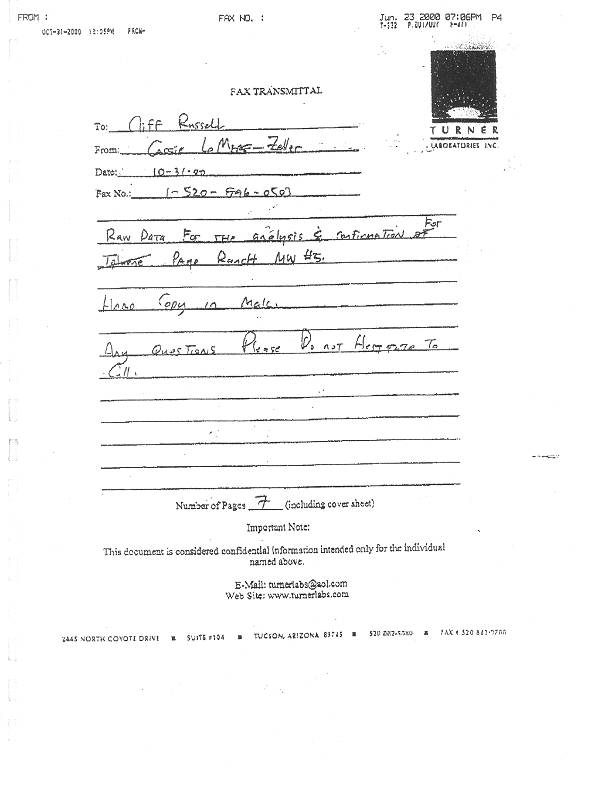 |
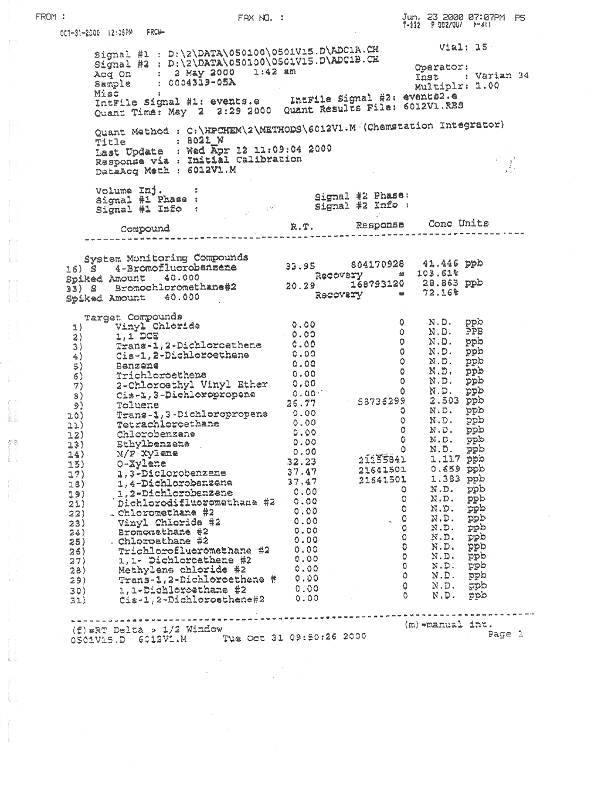 |
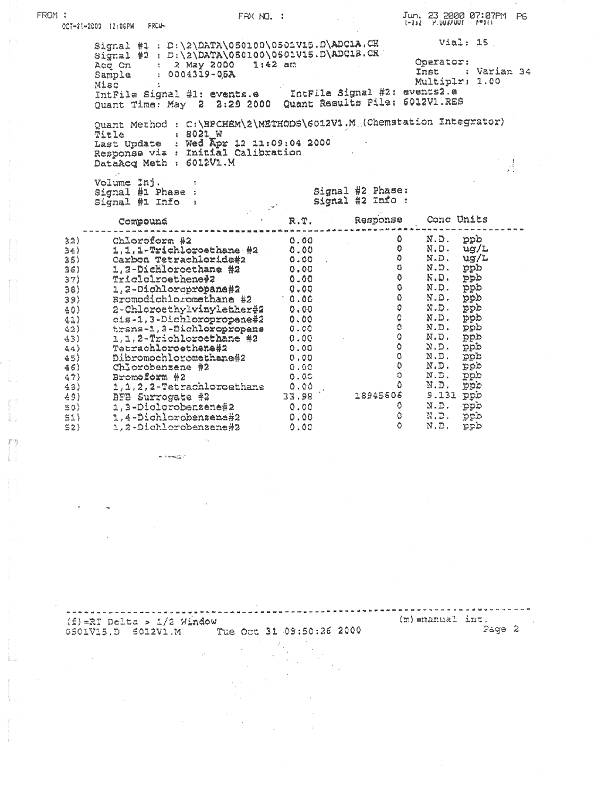 |
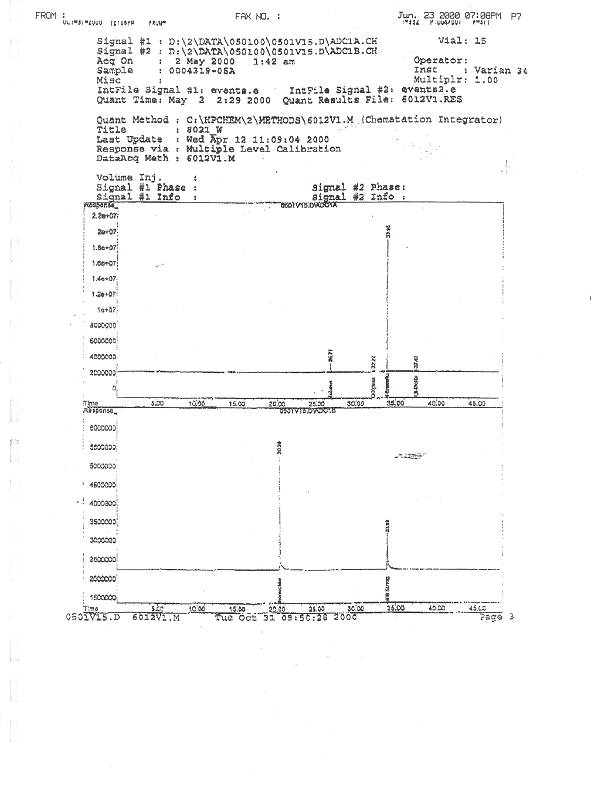 |
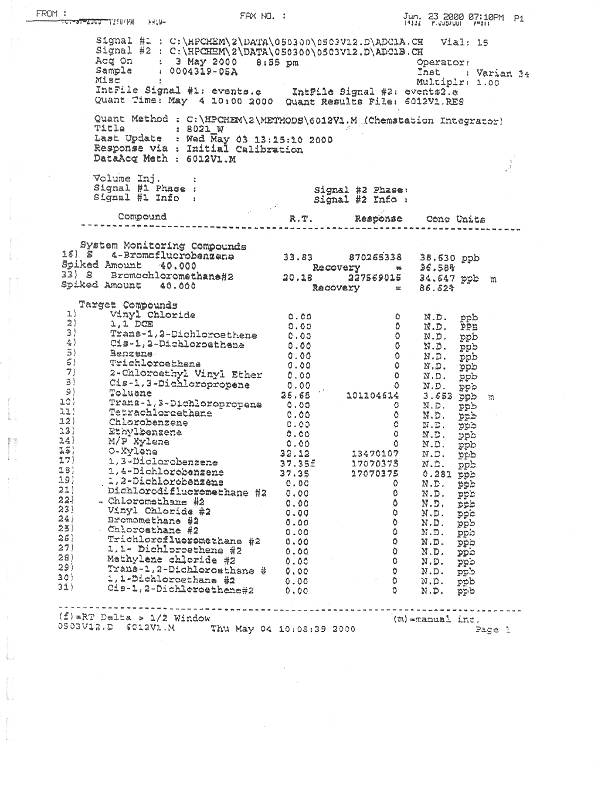 |
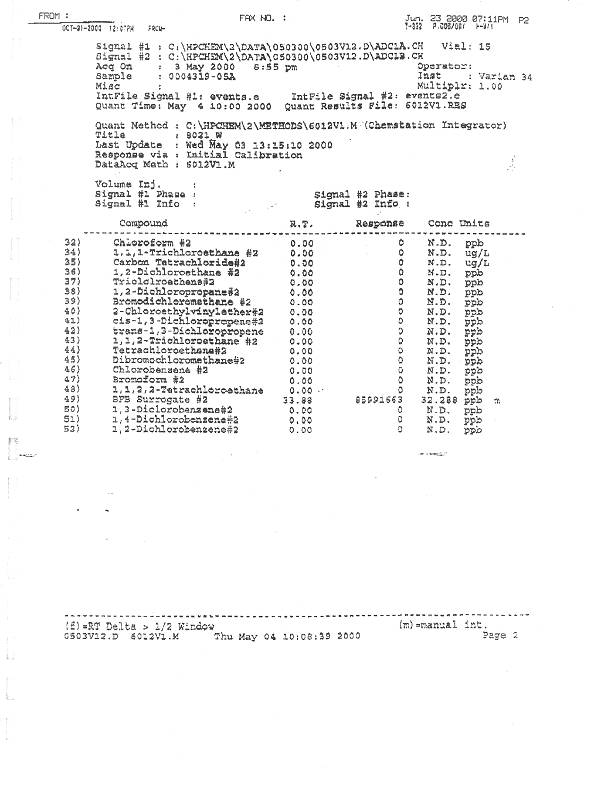 |
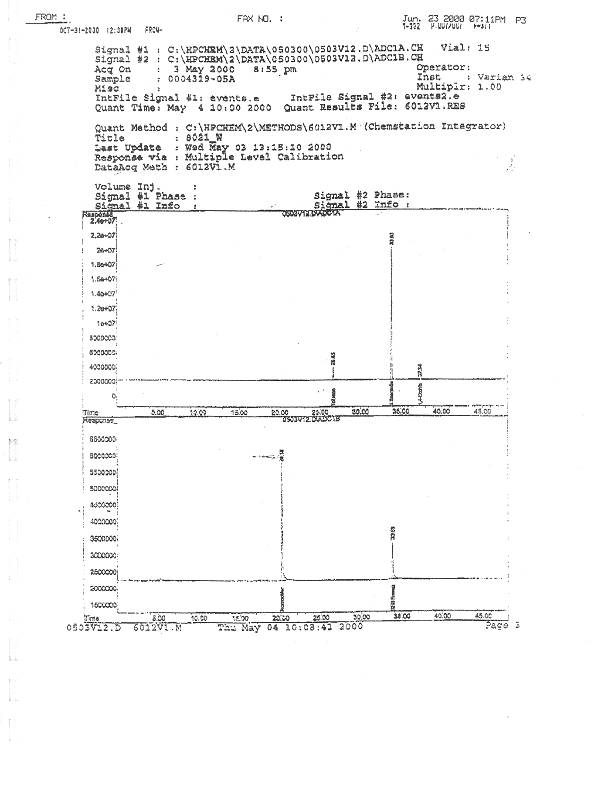 |
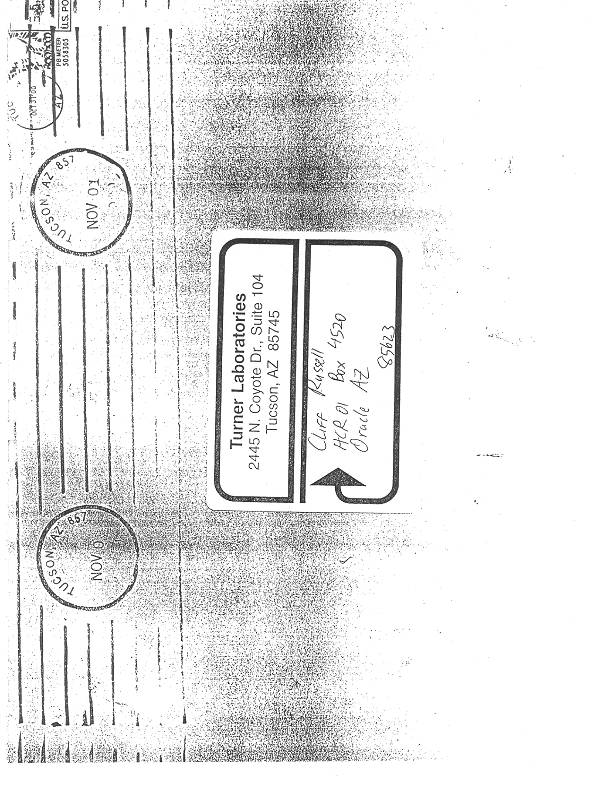 |
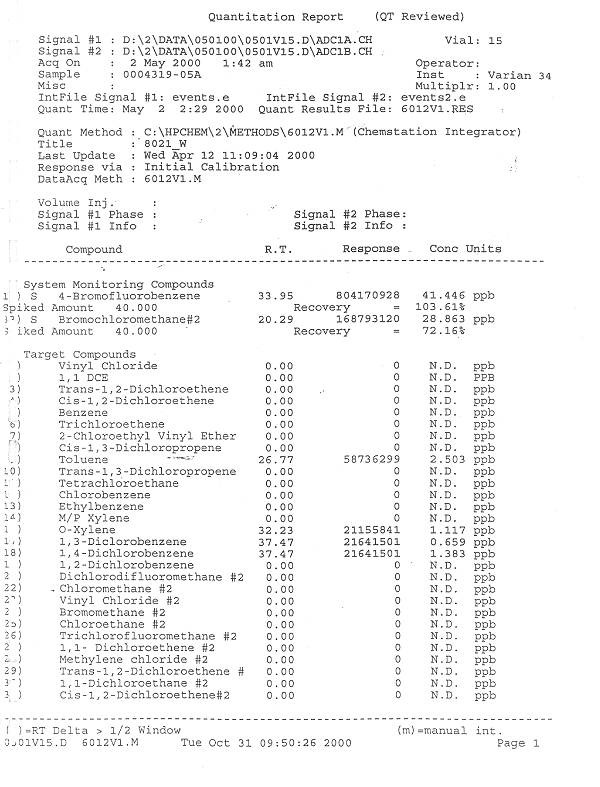 |
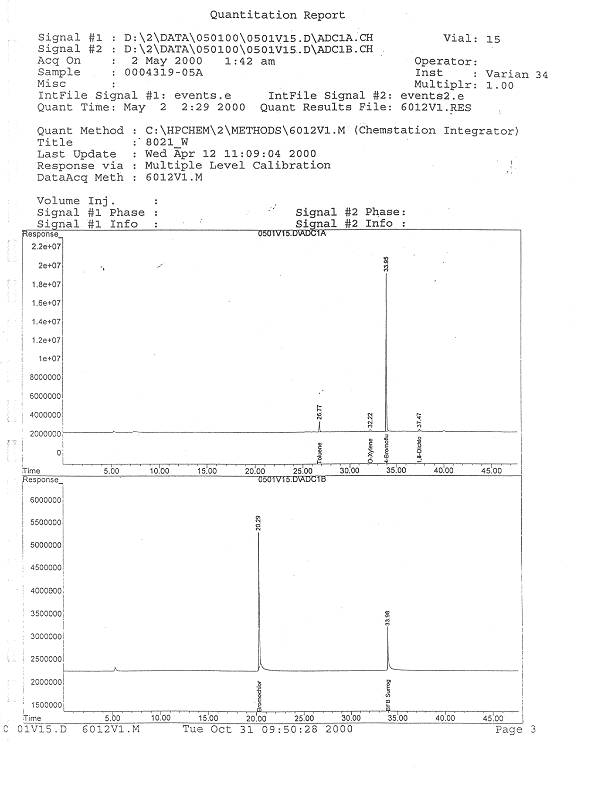 |
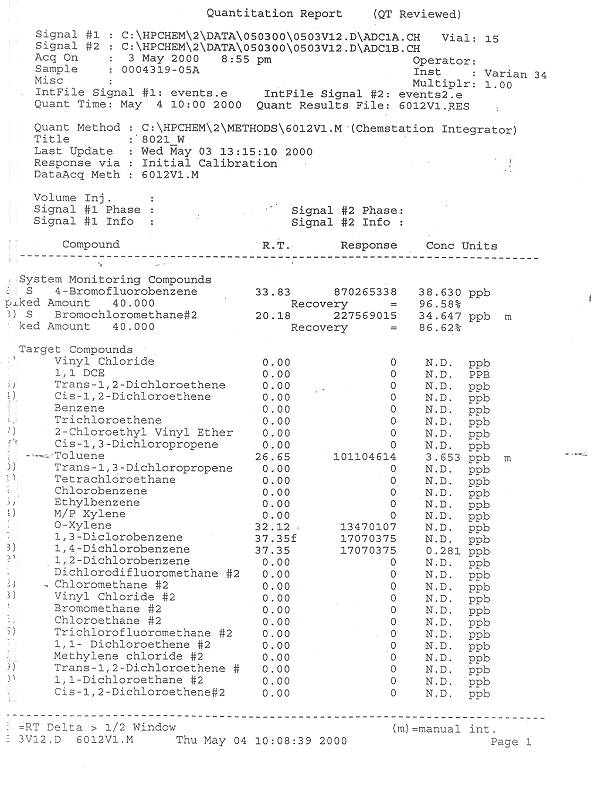 |
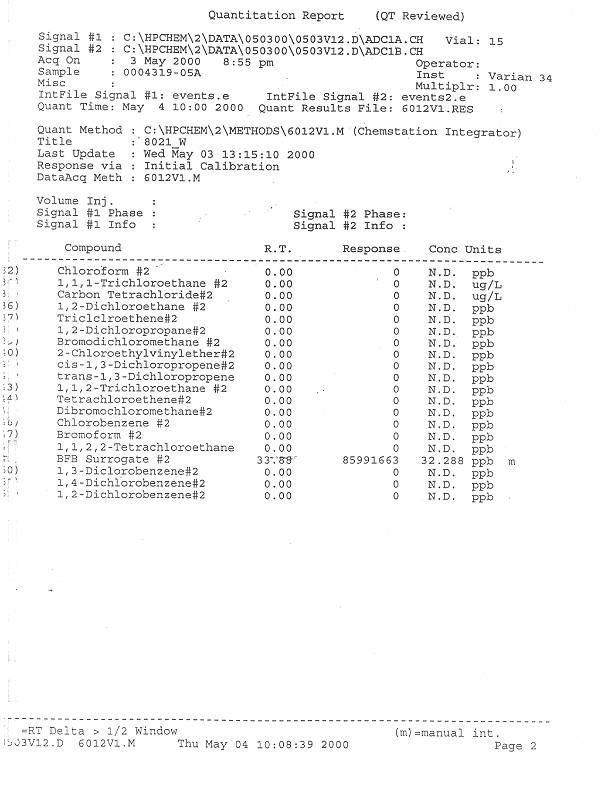 |
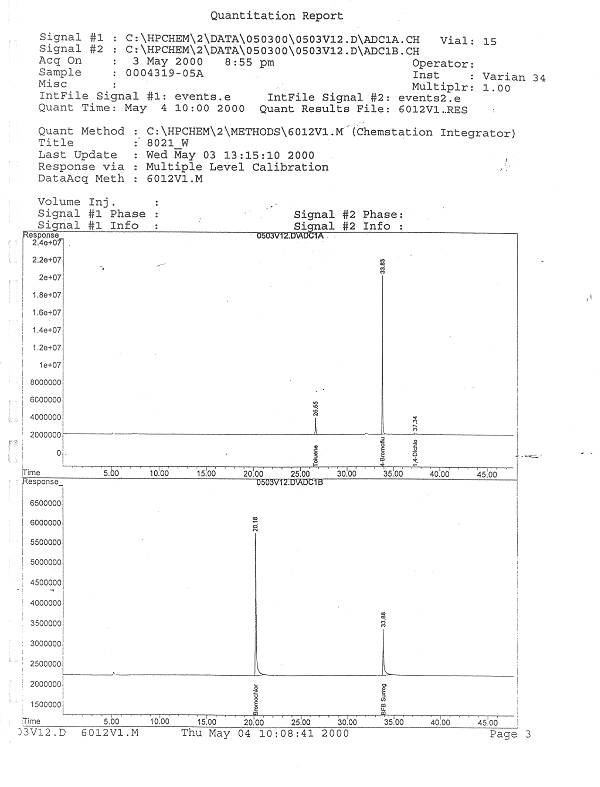 |
|
"Pinal OKs plan by Oracle dump despite concerns", By Hanna Miller ARIZONA DAILY STAR; November 2, 2000 |
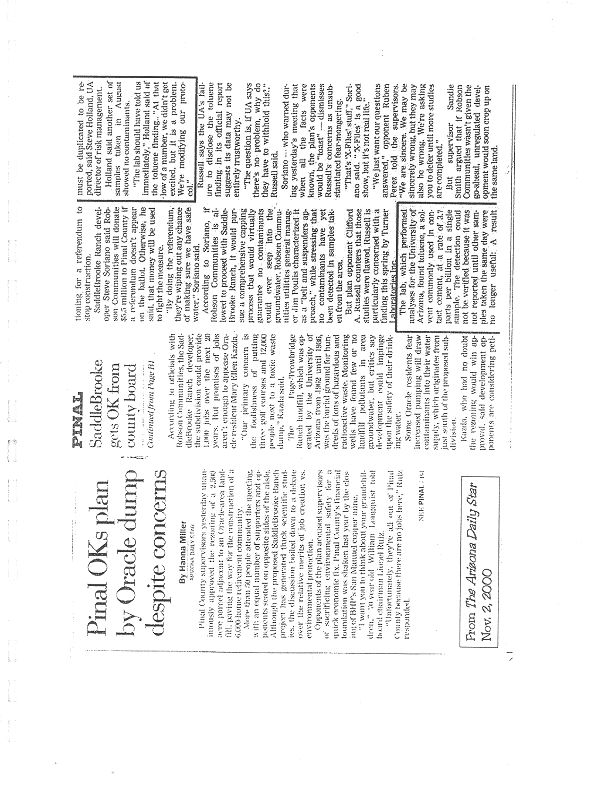 |
|
"Toxin may taint water near old Oracle-area landfill", by Tony Davis; December 25, 2000 |
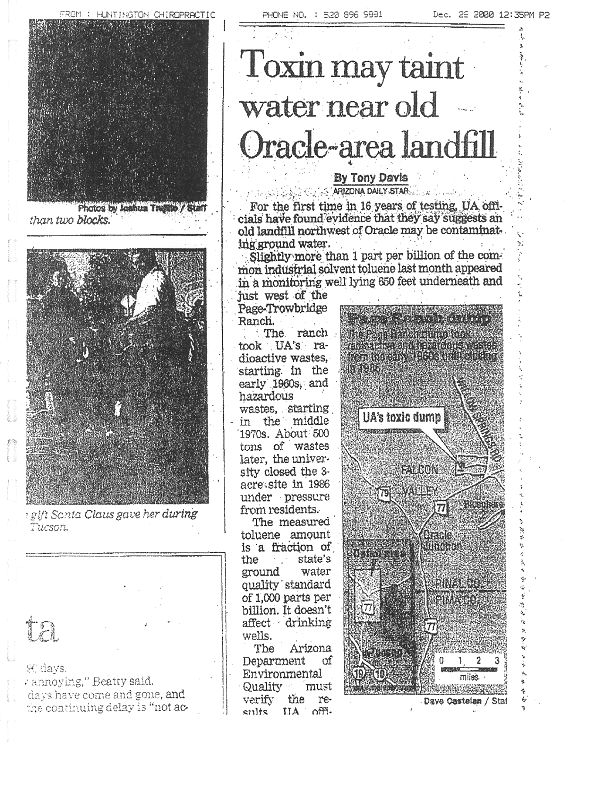 |
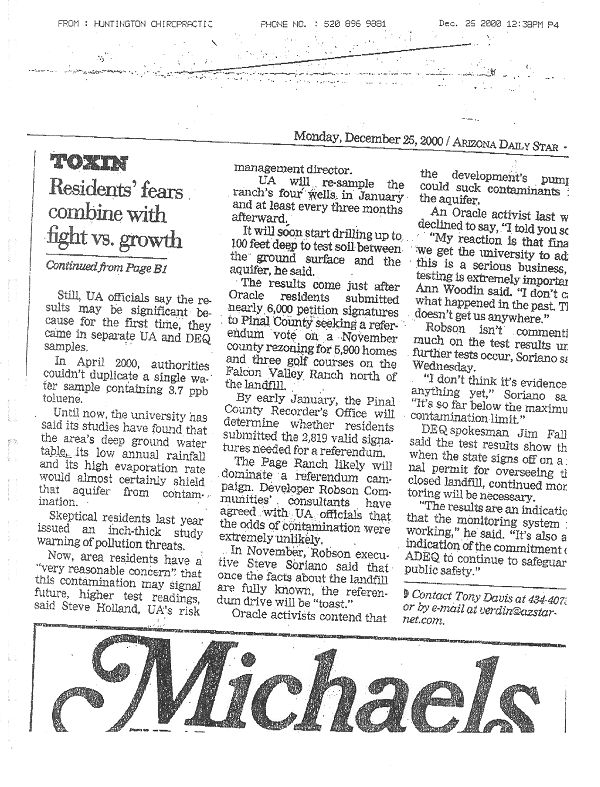 |
|
"Letter to the Editor and Mr. Andy Rush", by Steve Holland, San Manuel Miner, November 15, 2000 |
|
|
"Letter to the Editor and Mr. Steve Holland", by Nancy Turner and Timothy Rand, San Manuel Miner, November 15, 2000 |
|
|
|
"UA Officials cover up test confirming contaminants", by J.C. Huntington, The Oracle, Vol. 2 N0. 11, November 2000 |
|
|
|
Letter from Jill A. Zender, Fennemore Craig Law Offices, to Cliff Russell dated November 14, 2000 |
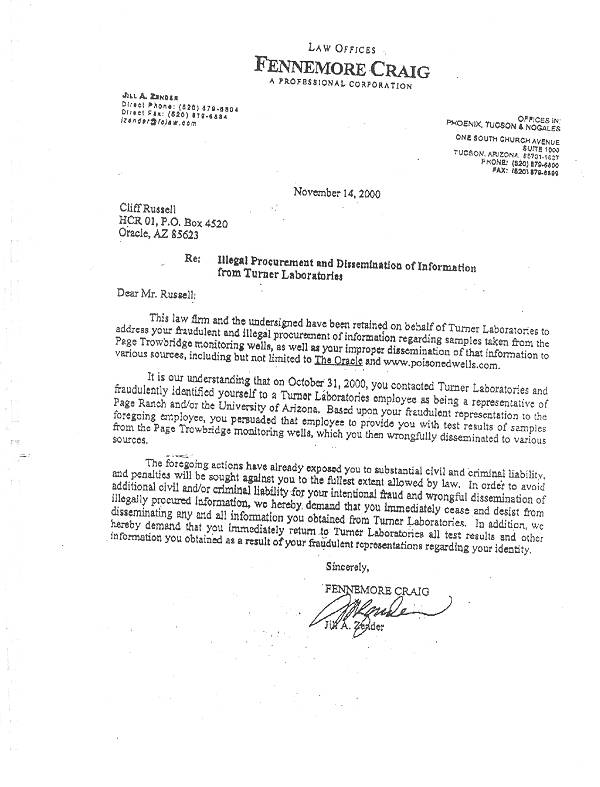 |
|
Letter from Cliff Russell, to Jill A. Zender, dated November 20, 2000 |
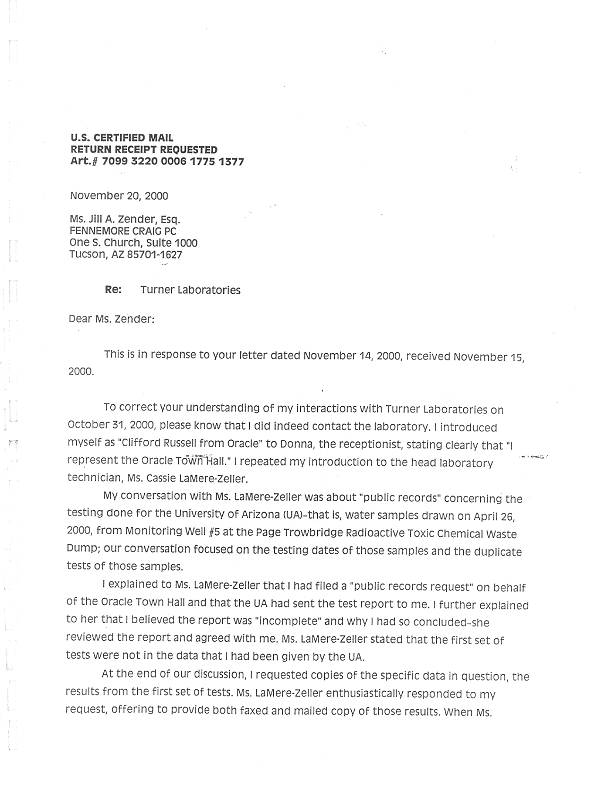 |
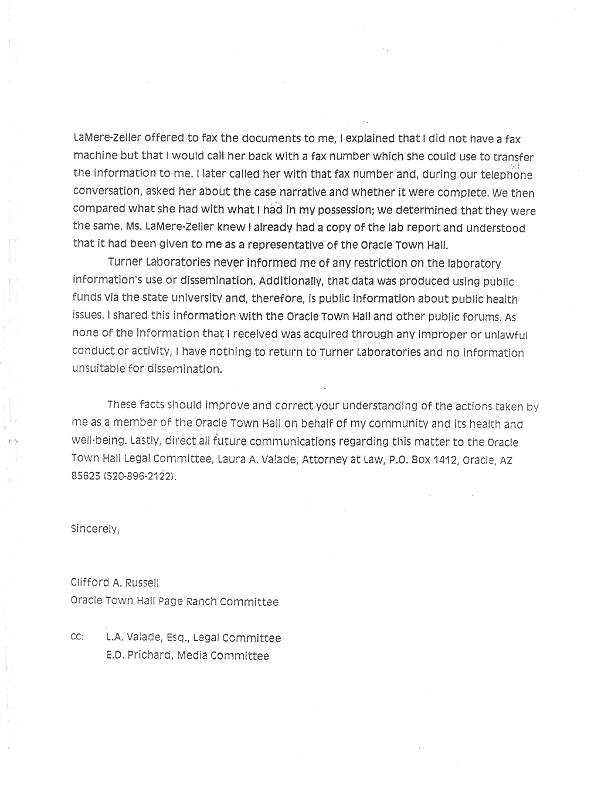 |
|
Map showing distance between UA Risk Management Offices (1610 N. Vine Ave, Tucson Arizona 85719) and Turner Laboratories, Inc. (2445 N. Coyote Dr., Tucson Arizona 85745) |
|
|
Letter from J.C. Huntington to Steve Holland and Editor of San Manuel Miner, dated 11/20/200 |
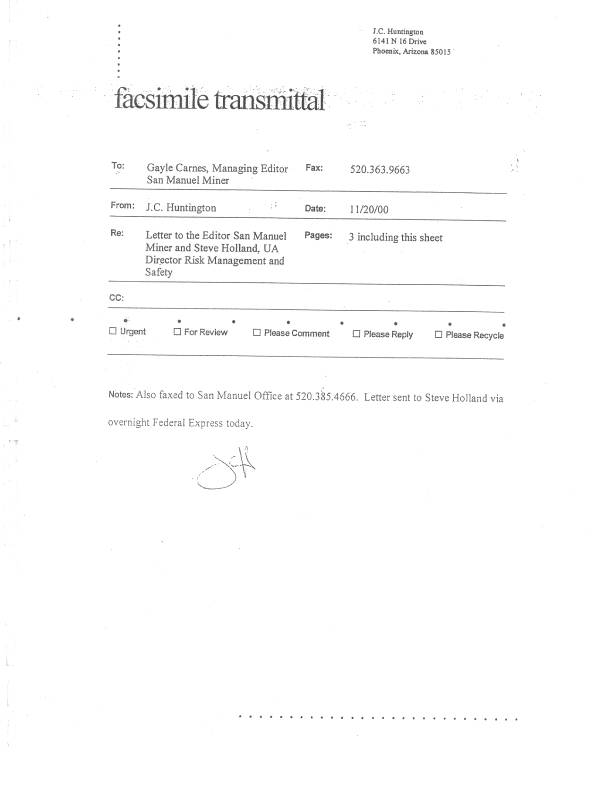 |
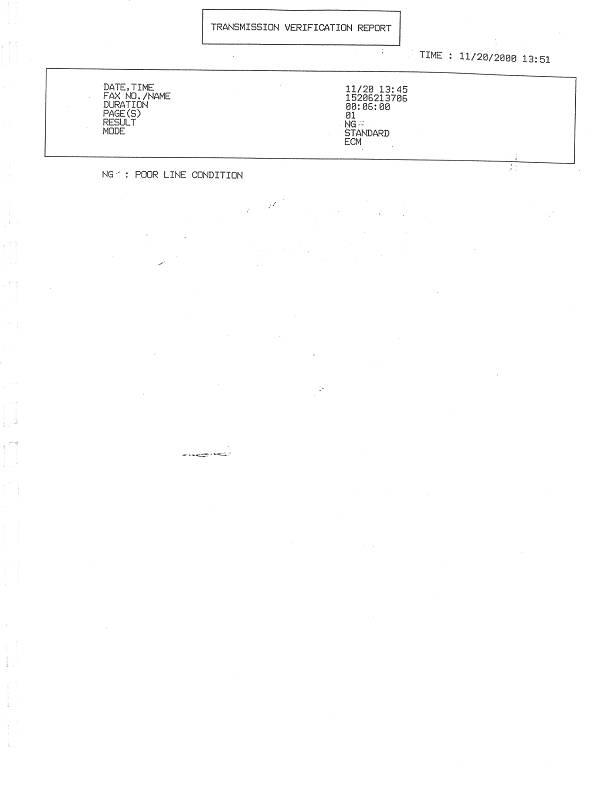 |
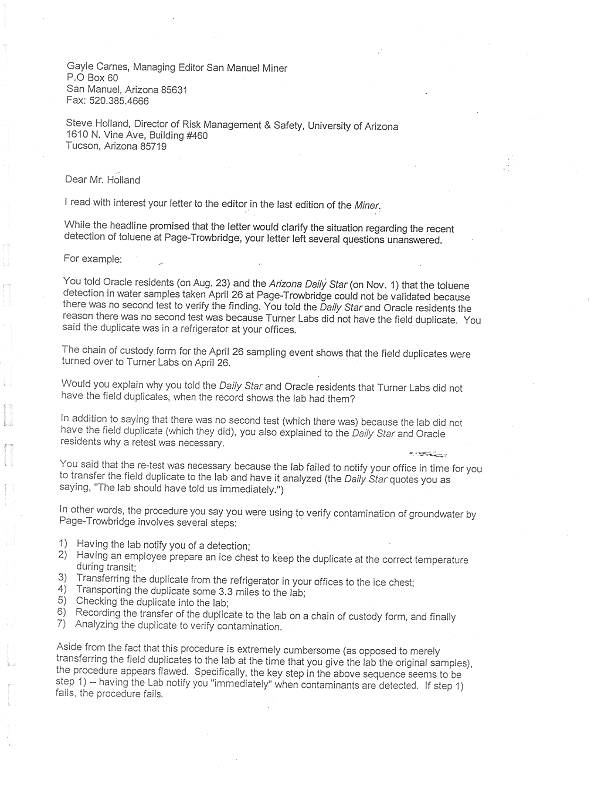 |
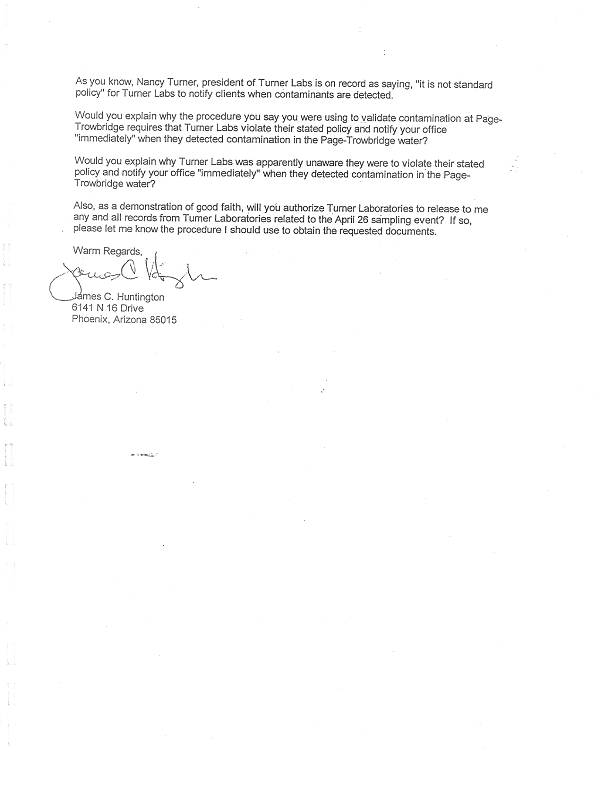 |
|
Letter from J.C. Huntington to Nancy Turner and Editor of San Manuel Miner, dated November 27, 2000 (this letter was not published in the San Manuel Miner) |
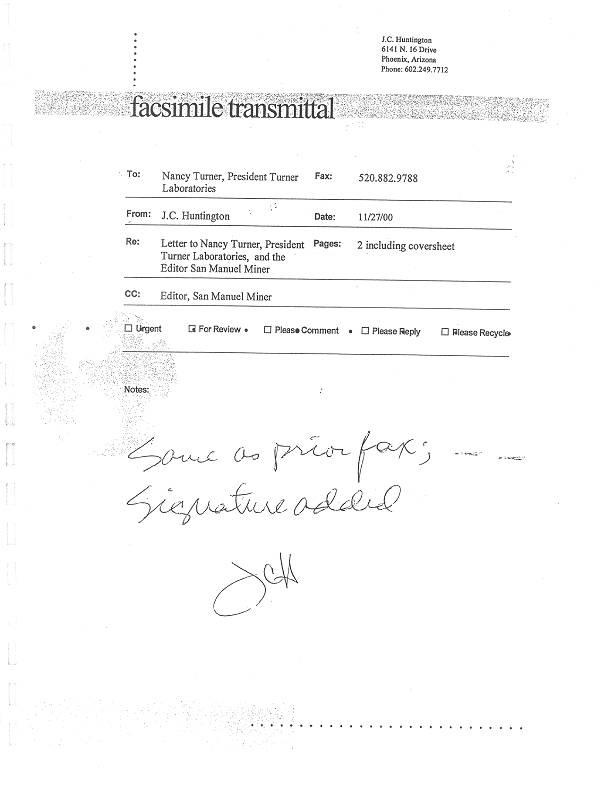 |
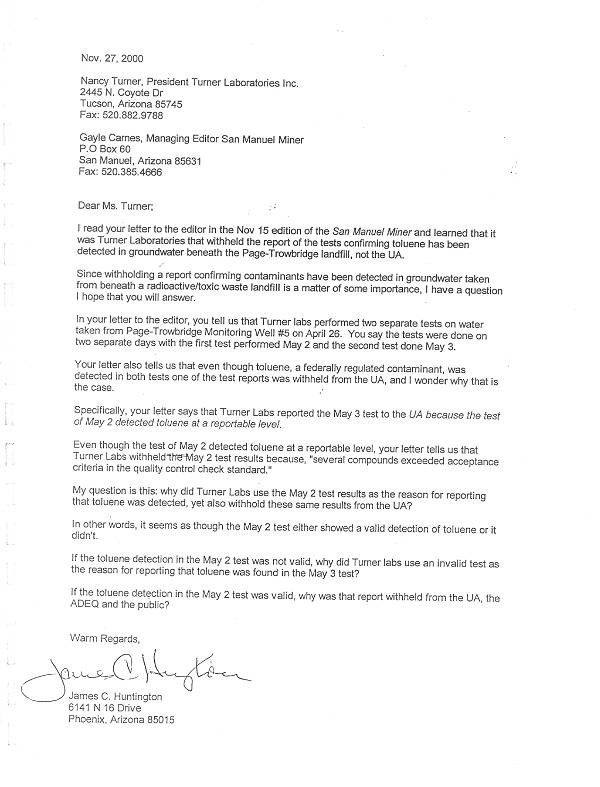 |
Use
The 'Back' Button On Your Browser
To
Return To Previous Page